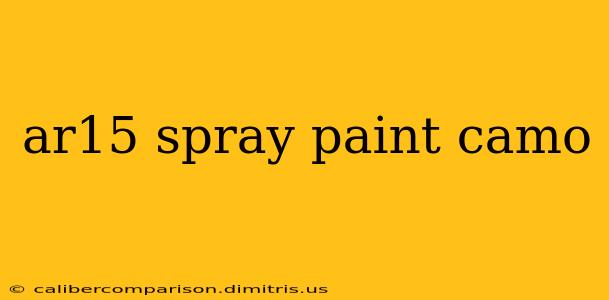Painting your AR-15 for camouflage isn't just about aesthetics; it's about enhancing its effectiveness in various environments. Whether you're a hunter, a competitive shooter, or simply an enthusiast, a well-executed camouflage job can significantly improve your firearm's concealment and blend it seamlessly into its surroundings. This guide dives deep into the process, offering expert advice and crucial considerations for achieving a professional-looking and durable finish.
Choosing the Right Spray Paint for Your AR-15
Selecting the appropriate spray paint is paramount. Substandard paints can chip, peel, or even affect the functionality of your firearm. Here's what to look for:
-
Durability: Opt for paints specifically designed for firearms or outdoor applications. These paints are formulated to withstand the rigors of handling, exposure to the elements, and recoil. Look for keywords like "high-durability," "UV-resistant," and "weatherproof."
-
Adhesion: The paint must adhere strongly to the metal or polymer surfaces of your AR-15. Poor adhesion will result in a peeling or chipping finish. Primer is essential for optimal adhesion, especially on metal surfaces.
-
Type: While Krylon and Rust-Oleum are popular choices, consider specialized firearm paints that offer better adhesion and durability. These paints are often formulated to withstand solvents and cleaning agents.
-
Color Selection: This is where your camouflage pattern comes in. Select colors that complement your intended environment. Popular choices include greens, browns, tans, and grays, often blended to create realistic patterns.
Essential Prep Work: The Key to a Lasting Finish
Before you even think about spraying, thorough preparation is crucial. This stage determines the longevity and quality of your camouflage job.
-
Disassembly: Completely disassemble your AR-15 as much as possible. This allows for even paint coverage and avoids accidental paint buildup in critical areas.
-
Cleaning: Clean every component meticulously. Use a degreaser to remove any oil, grease, or dirt. A clean surface ensures proper paint adhesion.
-
Masking: Use painter's tape to mask areas you don't want to be painted, such as the trigger group, sights, and any sensitive components. Take your time to ensure a clean and precise mask.
-
Priming: Apply a high-quality primer specifically designed for metal or polymer, depending on your AR-15's construction. This creates an even surface for the camouflage paint to adhere to and helps prevent rust. Allow the primer to dry completely according to the manufacturer's instructions.
Applying the Camouflage Pattern: Techniques and Tips
The application process is where your artistic skills and patience come into play. Here are a few techniques:
-
Freehand: This method requires practice and a steady hand. Use light, even coats, allowing each coat to dry before applying the next.
-
Stenciling: Create stencils from durable material like cardboard or Mylar to achieve a more precise and repetitive pattern. This is a great option for beginners.
-
Hydro-Dipping: This method creates a highly realistic and detailed camouflage pattern, but requires specialized equipment and materials.
Layering for Depth and Realism
To achieve a truly realistic camouflage effect, apply multiple layers of different colors. Start with base colors and gradually add highlights and shadows using lighter and darker shades. This layering creates depth and dimension, making your AR-15 blend seamlessly into its surroundings.
Post-Painting Care and Maintenance
Once the paint is completely dry (allow ample drying time), carefully reassemble your AR-15. Regular cleaning and maintenance are crucial to preserving your camouflage job. Avoid harsh chemicals and abrasive cleaners, and use a soft cloth for cleaning.
Conclusion: A Personalized and Effective Camouflage
Painting your AR-15 for camouflage can be a rewarding experience. By following these steps and paying attention to detail, you can achieve a durable, professional-looking finish that enhances the concealment and overall aesthetic appeal of your firearm. Remember, practice and patience are key to mastering this skill. With careful planning and execution, your AR-15 will be ready to disappear into its environment.

